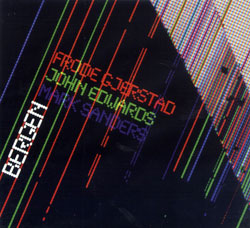
Read the liner notes of your favorite R&B albums of the '60s and early '70s and you often find one commonality: the same rhythm section. Frequently hired as a package deal, these musicians got the job not only because of astonishing talent, but their ability to both sustain and bring out the best in whichever artist was thrown their way that day.
Likewise, since their meeting in the early '90s, the synergistic duo of bassist John Edwards and drummer Mark Sanders has become a go-to workhorse in not only free jazz but a throng of other music scenes: from Evan Parker to Luigi Nono to Tony Bevan to Iannis Xenakis to the recent terrific collaboration with pianist Agustí Fernández (Un Llamp Que no S'acaba Mai), Edwards and Sanders do not simply complement, but soar as a highlight of each respective performance.
A live snapshot from the 2008 NattJazz Festival in Norway, this eager ménage a tois combines Edwards and Sanders's passion with wind player (clarinet, alto sax, in this case) Frode Gjerstad's febrile approach, one focused less on melody and texture, more on organization — and purposeful lapses thereof. With an agitated whisper the trio smashes into the 44-minute "Waiting for Ryanair Part 1", Gjerstad warbling with Edwards's rapid-fire strumming and Sanders's pit-a-pat brushes. Soon, they are a giant squid of activity: technically perfect clarinet runs spring from one register to the next, squealing at the top and growling from below; Sanders bends the pitch of toms, pedals shimmering hi-hats, rolls snares and simultaneously side-sticks, effortlessly dissecting and reconnecting broken ostinati; Edwards continues his nimble, forceful strums, shuffling them with bow work, sing-along scat (ala Thelonious Monk, though Edwards is louder and adopts an almost operatic voice) and polytonal walking lines, all executed with seemingly-augmented time and space adjustments.
The overwhelming nature of the album never turns uninteresting or boring, the trio recycling and expounding intentions with their relatively light ensemble. Moments of respite are few, but each is poignant — and generally led by Edwards. At the nine-minute mark, Sanders and Gjerstad sit back (the latter reaching for his alto) while the bassist digs in, realizing a passage that crosses the sounds of manually advancing turntable wheels, sinew and bones exuberantly stretched on a Medieval rack, a lurching barge nudging a pier and an aged redwood exhaling its last breath. After a few moments of this solo fit, he literally winds the piece back up, wrenching slides and tuning pegs, to open the door on the next warlike scene. At the final coda, Edwards once again steals the moment with his signature bass-as-sitar, pushing Sanders to release one last burst and Gjerstad to spill a few lilting phrases before closing the piece (then preparing for an equally compelling encore, "Waiting For Ryanair Part 2").
Sometimes, a review should merely read, "You need to listen"; and I lament that I cannot properly dance about architecture, so to speak, when describing this music. My adjectives and analogies feel hollow, generic and desperately brief when attached to this particular gig, as the aesthetic the group conjures is a pristine behemoth of jazz greatness. It is the type of set that will inspire many to pick up an instrument and attempt such feats, discourage (or encourage) current players who can't possibly measure up and give dulled aficionados a goose to renew interest in the genre.
Comments and Feedback:



More Recent Reviews, Articles, and Interviews @ The Squid's Ear...


|

